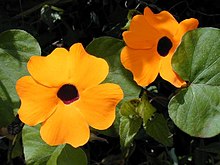
Thunbergia is a genus of flowering plants in the family Acanthaceae. It includes 150 species native to tropical and subtropical regions of sub-Saharan Africa, Madagascar, southern Asia, New Guinea, and Australia. Thunbergia species are vigorous annual or perennial vines and shrubs growing to 2–8 m tall. The generic name honours the Swedish naturalist Carl Peter Thunberg (1743-1828).

Lepechinia fragrans is a flowering herbaceous shrub known by the common names island pitchersage and fragrant pitchersage. It is a member of the Lamiaceae, or mint family, but like other Lepechinia, the flowers are borne in racemes instead of in mintlike whorls.

Momordica balsamina is a tendril-bearing annual vine native to the tropical regions of Africa, introduced and invasive in Asia, Australia, Central America, and North America, where they have been found in some parts of Florida. In 1810, Thomas Jefferson planted this vine in his flower borders at Monticello along with larkspur, poppies, and nutmeg.
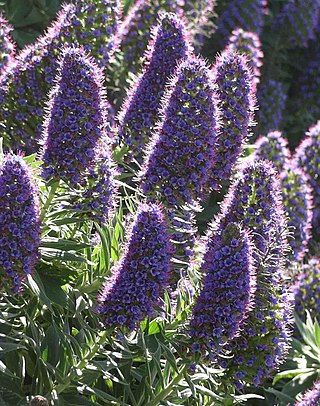
Echium candicans, the 'Pride of Madeira', is a species of flowering plant in the family Boraginaceae, and genus Echium, native to the island of Madeira. It is a large herbaceous perennial subshrub, growing to 1.5–2.5 m.

Bougainvillea glabra, the lesser bougainvillea or paperflower, is the most common species of bougainvillea used for bonsai. The epithet 'glabra' comes from Latin and means "bald".
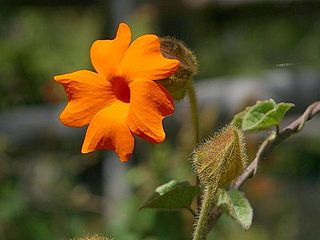
Thunbergia gregorii, commonly known as orange clockvine or orange trumpet vine, is a herbaceous perennial climbing plant species in the family Acanthaceae, native to East Africa and sometimes cultivated as an ornamental vine. The bright, pure all-orange flowers distinguish it from the related black-eyed Susan vine.
Hexalobus bussei is a species of plant in the family Annonaceae. It is native to Cameroon. Ludwig Diels, the German botanist who first formally described the species, named it after another German botanist, Walter Busse, who collected the sample that Diels examined.

Hexalobus crispiflorus is a species of plant in the family Annonaceae. It is native to Angola, Benin, Cameroon, Central African Republic, Congo, DR Congo, Gabon, Ghana, Guinea, Guinea-Bissau, Ivory Coast, Liberia, Nigeria, Senegal, Sierra Leone, Sudan, Togo and Zaire. Achille Richard, the French botanist who first formally described the species, named it after its wavy petals of its flowers.

Callisia repens, also known as creeping inchplant or turtle vine, is a succulent creeping plant from the family Commelinaceae. This species comes from Central and South America.

Lonicera acuminata, commonly known as fragrant grove honeysuckle or vine honeysuckle, is a plant species of honeysuckle native to China to Southeast Asia and India.
Larsenianthus arunachalensis is a species of the genus Larsenianthus in the ginger family (Zingiberaceae).. It was first described in 2010 and is native to northeastern India, and Myanmar.

Pseuduvaria glabrescens is a species of plant in the family Annonaceae. It is native to Australia. L.W. Jessup, the botanist who first formally described the species using the synonym Pseuduvaria mulgraveana var. glabrescens, named it after the underside of its leaves which have the quality of becoming hairless as they mature.
Pseuduvaria grandifolia is a species of plant in the family Annonaceae. It is native to New Guinea. Otto Warburg, the German-Jewish botanists who first formally described the species using the basionym Stelechocarpus grandifolius, named it after its large leaves.
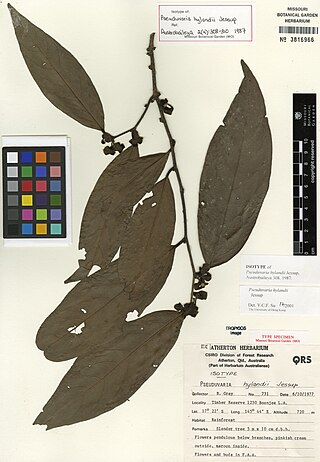
Pseuduvaria hylandii is a species of plant in the family Annonaceae. It is native to Australia. L.W. Jessup, the botanists who first formally described the species, named it after Bernard Hyland an Australian botanist who collected the specimen he examined.
Pseuduvaria mollis is a species of plant in the family Annonaceae. It is native to New Guinea. Otto Warburg, the German-Jewish botanists who first formally described the species using the basionym Goniothalamus mollis, named it after the soft hairs on its leaves and petals.
Pseuduvaria silvestris is a species of plant in the family Annonaceae. It is native to New Guinea. Ludwig Diels, the botanist who first formally described the species under the basionym Orophea silvestris, named it after the forested habitat the specimens he examined were found growing in near the Waria River.

Pseuduvaria villosa is a species of plant in the family Annonaceae. It is endemic to Australia. L.W. Jessup, the botanist who first formally described the species, named it after its leaves and branchlets which are shaggy with long soft hairs.
Thunbergia bicolor, also known as the bicolour clock vine, is a species of flowering plant within the family Acanthaceae.
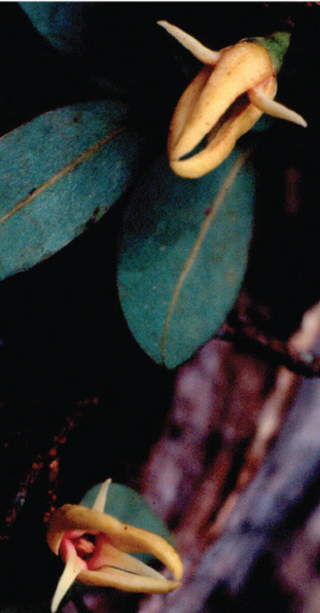
Xylopia arenaria is a species of plant in the Annonaceae family. It is native to Kenya, and Tanzania. Adolf Engler, the botanist who first formally described the species, named it after its growth in sandy places.

Castilleja rhexiifolia, commonly called rosy paintbrush, subalpine paintbrush, or rhexia-leaved paintbrush, is a species of plant in Orobanchaceae, commonly known as the broomrape family. They are a common flower found in moist habitats near or above timberline in the Rocky Mountains and the Pacific Northwest. Like most members of the Castilleja genus, they are partially parasitic plants.
